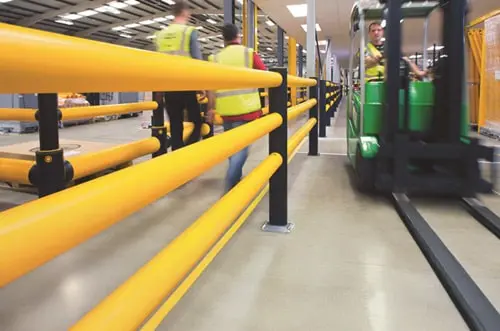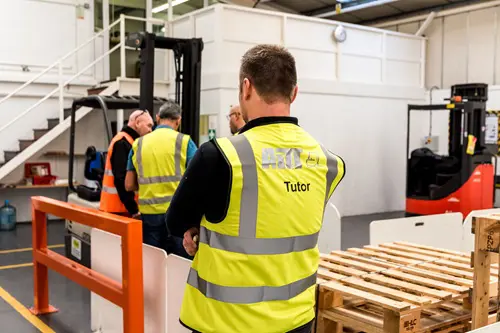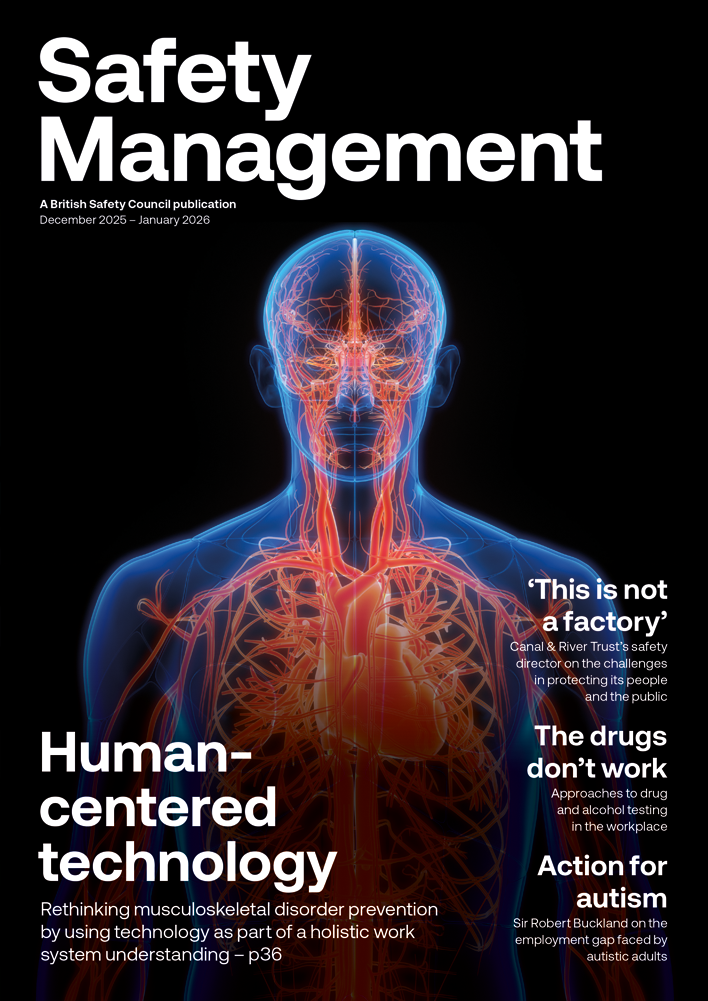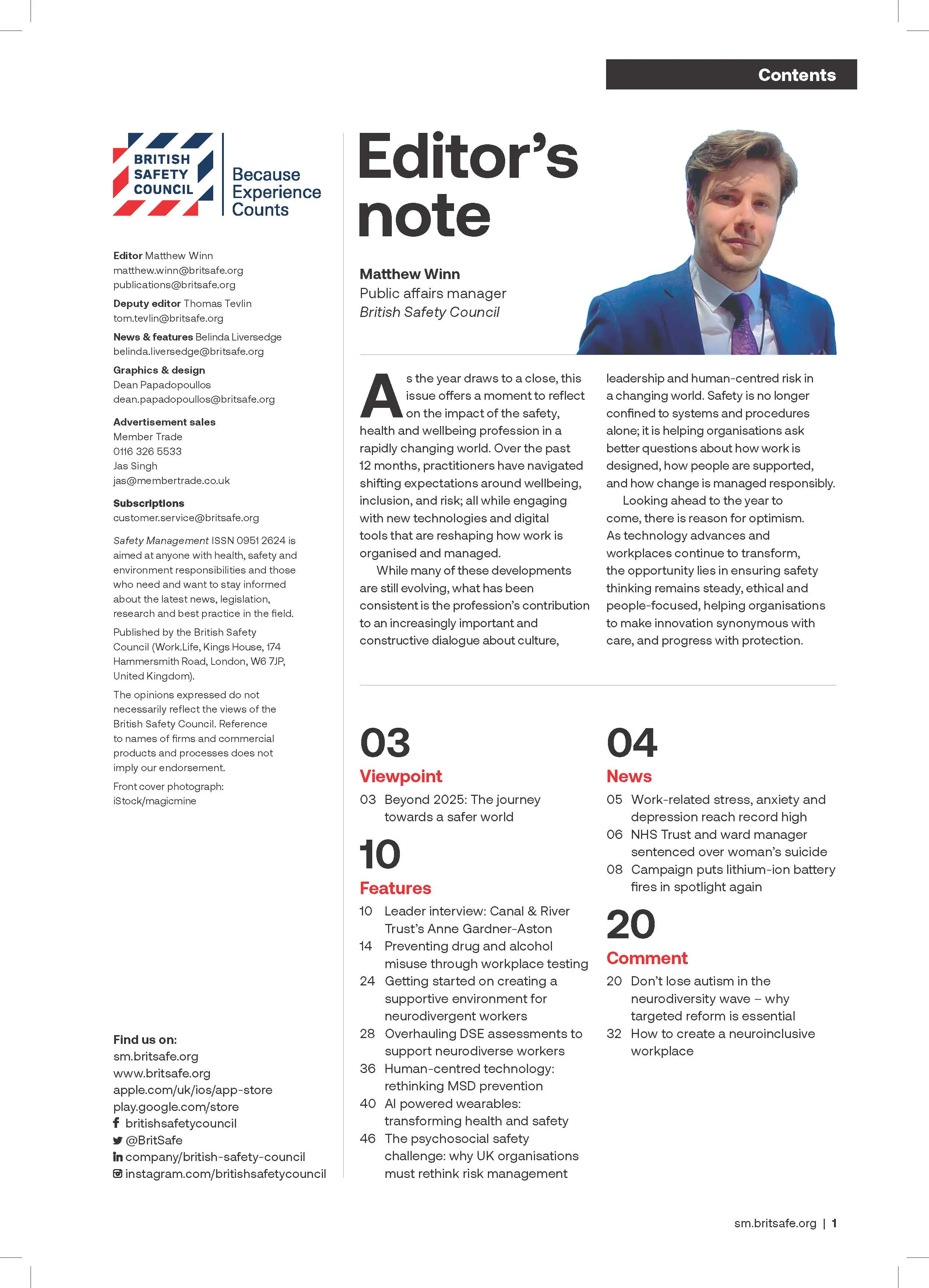Slip injuries to workers and members of the public can have a major financial impact on a business in terms of fines, compensation payouts and higher insurance premiums, so it’s essential to take a scientific approach to understanding and reducing slip risks.
Features
The £11 million sales safety tax: why every business needs to tackle slip risks
Picture this: you’re walking through your workplace, keenly aware of potential slip hazards. You’ve read the memos, attended the safety briefings and even nodded sagely during discussions about the importance of slip prevention. Yet when you spot a small puddle in the corridor, you simply step over it, making a mental note to mention it to someone... eventually.
But here’s the cold, hard truth that’ll make you think twice about stepping over that puddle: that seemingly harmless bit of moisture could cost your organisation £11 million to recover from.
Let me share a story that illustrates why this isn’t hyperbole, it’s mathematics.
It was a sunny morning in August 2015 when 91-year-old Dennis Satchell set out for his weekly shop at the Tesco Extra in Jarman Way, Hemel Hempstead. As he pushed his trolley into the meat and dairy aisle, Mr Satchell’s feet suddenly slipped from under him. In a heart-stopping moment, he crashed to the floor, his hip taking the brunt of the impact.
 Slips consistently account for around 30 per cent of all ‘RIDDOR’ non-fatal workplace injuries in the UK. Photograph: iStock
Slips consistently account for around 30 per cent of all ‘RIDDOR’ non-fatal workplace injuries in the UK. Photograph: iStock
The consequences were devastating. Multiple hip fractures, surgery, constant pain and a life forever changed. But this wasn’t just a story of one man’s misfortune. This ‘simple slip’ resulted in a £733,333 criminal fine for Tesco. Yet here’s the kicker: £733,333 wasn’t the real cost to them. To make the money to pay that fine, Tesco needed to sell items to recoup that cost. With their gross margin of approximately 6.7 per cent, they needed £10,945,269 of sales to recover from just the fine alone.
Nearly £11 million in sales to cover one slip incident. Still think slip safety isn’t a financial priority?
The hidden mathematics of safety failure
“The cost of an error is never just the error; it’s the cost of correcting it,” wrote bestselling author James Clear. In slip safety, this couldn’t be truer.
Here’s the fundamental business principle safety professionals sometimes miss in their focus on protecting people from harm: we need to illustrate the financial ROI (return on investment) of our work. Put simply: to make enough profit to pay for things, you have to make sales. But to deliver those sales, you suffer costs of sales. This leaves you with your gross profit. It’s only from your gross profit that you can pay expenses like fines or insurance claims.
So, when you have an additional expense, you need to make additional sales to produce the gross profit to cover those expenses. A simple example: sell a meal for £100, subtract the cost of producing that meal of £35, and this leaves a gross profit of £65. If you face a £733,333 fine and your gross margin is 6.7 per cent, you need nearly £11 million in additional sales to cover it.
This is what I call the ‘Sales Safety Tax’: the hidden burden that every slip incident places on your organisation’s revenue requirements.
 Photograph: Slip Safety Services
Photograph: Slip Safety Services
Why slips? The statistical reality
You might be wondering: why focus on slips specifically? After all, there are plenty of other safety risks to worry about. The answer lies in cold, hard statistics that reveal slips as the most financially dangerous safety risk most organisations face.
Slips consistently account for around 30 per cent of all ‘RIDDOR’ non-fatal workplace injuries in the UK (i.e. injuries that must be reported to the enforcing authorities, like the Health and Safety Executive, or HSE). Year after year, decade after decade, this figure remains stubbornly static.
We’re not improving, and the costs keep mounting.
But here’s the statistic that should really grab your attention: even if you’ve never had a slip claim, slips are likely costing you around 35 per cent of your liability insurance premium. That’s right – more than a third of what you’re paying your insurer is covering the risk of slip incidents, whether they happen or not.
AXA Insurance reports that slips alone cost them £80 million in 2018; that was 2.5 times more than manual handling claims. Given AXA’s market share represents less than 5 per cent of UK casualty insurance, we’re looking at over £1.6 billion in slip-related claims annually across the UK alone.
Ask yourself this: are you putting 2.5 times as much effort into slip prevention as you are into manual handling? If not, you’re misallocating your safety resources based on financial risk.
The brutal truth is that slips are statistically the most likely safety incident to hit your bottom line. While you might never face a major fire or serious machinery accident, the chances of dealing with slip incidents over your career as a senior business leader or safety practitioner? A near certainty.
 Slips are statistically the most likely safety incident to hit your bottom line. Photograph: iStock
Slips are statistically the most likely safety incident to hit your bottom line. Photograph: iStock
Claim costs: the visible tip of the iceberg
Let’s start with what most people think about when they consider slip costs: the insurance claims. The average slip-related claim costs around £12,500 for a public liability claim and £16,500 for an employers’ liability claim. That might not sound astronomical, but remember our mathematics lesson.
If your organisation has a 30 per cent gross margin, that £14,000 claim requires you to sell an additional £46,667 to recover your costs. Not too bad, you might think. But that’s just the average.
Let me share two examples from leading claims defence law firm Keoghs that show how quickly these costs can escalate.
A major grocery retailer faced a March 2016 incident where a customer slipped on rainwater in the foyer. The lack of proactive inspections and inadequate matting led to a liability admission. Multiple injuries, including spinal fracture, resulted in a total claim cost of £534,000.
A global warehousing company dealt with an employee who slipped on sludge and polythene on loading bays in July 2017. Vicarious liability with contributory negligence led to a £122,000 settlement for ligament damage to the knee.
These aren’t outliers – they’re examples of what happens when ‘average’ slip incidents meet vulnerable individuals or poor safety measures. That £534,000 claim? For a retailer with a 25 per cent gross margin, that’s £2.1 million in additional sales needed to recover.
Criminal fine costs: the sledgehammer blow
If claims are the tip of the iceberg, criminal fines are the sledgehammer to your financial stability. Unlike insurance claims, these come straight from your bottom line with no coverage.
The Tesco case we opened with isn’t unique. Consider the Co-op prosecution following Stanley May’s tragic slip death: a £400,000 fine that required millions in sales to recover. Since 2016, criminal fines for health and safety breaches have regularly surpassed £1 million, making our £11 million sales calculation not just relevant, but conservative for larger organisations.
These fines serve as a stark reminder that slip safety isn’t just about preventing accidents; it’s about avoiding financial catastrophe. Criminal fines have no insurance coverage, no spread risk, no gradual impact. They hit immediately and demand immediate recovery through increased sales performance.
Insurance premiums: the recurring punishment
Here’s where many organisations fool themselves: “Our insurance covers us, so we’re okay.” But insurers aren’t in business to make losses. They make money through investment returns and achieving profits on premiums after paying claims.
If your claims exceed your premium, your future premiums will rise accordingly. So, whilst the initial cost of a slip claim might not hit your P&L (profit and loss) immediately, it absolutely will in the long term.
Don’t forget about excesses either. Just like your car insurance might have a £250 excess, your liability insurance often has excesses around £25,000 for larger SMEs, potentially reaching £250,000 for very large organisations. Given average claim costs, much of your slip-related expenses may be coming directly from your P&L, not from your insurer.

The recurring nature of increased premiums means that one bad year of slip incidents can impact your finances for years to come, creating a compounding effect on your ‘Sales Safety Tax’.
Conversely, if you take slips seriously, you can see significant insurance savings. One property owner client got a £65,000 reduction in their premium after working with my team to create a slip safety strategy and presenting this back to the insurer.
Uninsured costs: the hidden multiplier
HSE estimates that the uninsured costs of accidents range from eight to 36 times the insured costs. This means your £14,000 slip claim could actually be costing you anywhere from £112,000 to £504,000 in total costs.
These uninsured costs include lost productivity while dealing with incidents, management time spent on investigations, replacement staff costs, potential regulatory attention and follow-up activities. When someone is hurt, the ripple effects spread throughout your organisation. And as you now know, the most likely cause for this cost is a slip.
Consider the administrative burden: incident forms, investigation meetings, supplier discussions, insurance correspondence, potential legal proceedings. All of this requires human resources that could otherwise be focused on productive activities. The cumulative cost of this ‘safety tax’ on your organisation’s time can be staggering.
Intangible costs: the reputation tax
Beyond the measurable costs lie the intangibles that can impact your business for years. Damaged reputation affects customer confidence, employee morale and your ability to attract top talent. News of safety incidents spreads quickly in our connected world, and recovery from reputational damage often takes far longer than financial recovery.
Consider how slip incidents affect employee behaviour: increased caution, reduced efficiency and potential reluctance to report future issues for fear of blame. These cultural impacts compound over time, creating hidden drags on organisational performance.
 Photograph: iStock
Photograph: iStock
The sales reality check
Let’s bring this home with some concrete examples across different industries. Here’s what recovering from a £100,000 slip incident looks like depending on your gross margin:
- Manufacturing (6 per cent margin): £1,667,000 in additional sales required
- Retail (25 per cent margin): £400,000 in additional sales required
- Food service (30 per cent margin): £333,000 in additional sales required
- Professional services (65 per cent margin): £154,000 in additional sales required.
To put this in perspective: that manufacturing company needs to sell 1.67 million additional products at £1 each, or 167,000 products at £10 each, just to recover from one slip incident. The retail store needs to generate the equivalent of £400,000 in additional customer spending. The restaurant needs an extra £333,000 in meals served.
Suddenly, that puddle you stepped over doesn’t seem so harmless, does it?
What next: the prevention pathway
The good news? This Sales Safety Tax is entirely preventable. Over the past 12 years, I’ve worked with over 4,000 client sites, and those implementing scientific slip prevention achieve an average 57 per cent reduction in incidents.
The key lies in understanding what I call the ‘CHIMES’ framework – the six factors that contribute to slip risk:
- Contamination: managing what gets on your floors and how quickly it’s removed
- Heel: ensuring appropriate footwear for your environment
- Individual: understanding human factors and behaviour patterns
- Maintenance: implementing effective cleaning and upkeep regimes
- Environment: optimising lighting, drainage, matting and building design
- Surface: ensuring floors are scientifically proven to be slip-resistant when wet.
The most effective approach combines physical improvements (like anti-slip treatments that can improve safety by 50,000x), procedural changes (improved cleaning regimes) and cultural shifts (staff training and engagement). When implemented systematically, these measures don’t just prevent accidents, they protect your sales capacity. And, of course, they allow you to sleep easily at night with the scientific certainty you’re controlling slip risks.
All these points and much more are covered in detail in my book Prevent Slip Accidents With Slipology. If you’d like a free copy of the book, feel free to email me on [email protected] and we will get one sent out to you.
Your next (safer) step
Every pound you invest in scientific slip prevention protects exponentially more in potential sales requirements. The question isn’t whether you can afford to implement proper slip safety measures… it’s whether you can afford not to?
Start by calculating your own Sales Safety Tax exposure. What would a major slip incident cost your organisation in sales terms? Once you see that figure, prevention becomes not just a moral imperative, but a financial necessity.
Because in the end, the most expensive slip is the one that happens next.
Actions:
1. Calculate your organisation’s Sales Safety Tax
2. Take 3.5 minutes to self-assess your current slip prevention strengths and weaknesses with our free online tool: scorecard.slipsafety.co.uk
3. Join me in raising awareness about slip safety by posting on social media with the hashtag #Sliptember in September.
Christian Harris is the founder of Slip Safety Services and author of the book 'Prevent Slip Accidents With Slipology'. He also hosts the Safety And Risk Success Podcast, as well as fortnightly Safety Roundtable interactive Zoom sessions.
For more information see:
slipsafety.co.uk
[email protected]
linkedin.com/company/slipsafety
linkedin.com/in/christian-harris-slip-safety
FEATURES

Underpinning safety training with neuroscience for long lasting impact
By SSE Active Training Team (ATT) on 30 November 2025
A behavioural safety training programme developed by Active Training Team for energy provider SSE has been carefully designed with neuroscientific principles in mind – resulting in a prestigious industry award for Best Training Initiative in 2024.

Why a painted line will never be enough
By UK Material Handling Association (UKMHA) on 20 November 2025
Businesses that operate material handling equipment like forklifts are being urged to submit accident and near miss details to a new confidential reporting portal so the industry can identify what needs to be done to improve safety standards.

Why workplace transport training is changing in 2026 and what it means for employers
By AITT on 26 November 2025
New workplace transport training categories due in January mean it is essential to ensure operators of material handling equipment have the necessary training for the exact type of machine they use, and accredited training providers are an ideal source of advice and conversion training.



